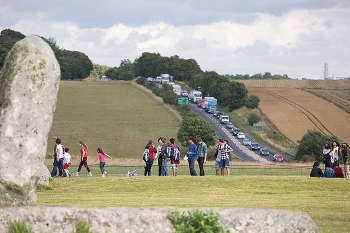Highways England has sought to play down the additional carbon dioxide (CO2) emissions from its planned Stonehenge tunnel, which will increase congestion on part of the route as a result of additional, induced traffic.
A report from the National Audit Office (NAO) last month disclosed that Highways England expects the controversial 3.3km tunnel for the A303 to increase carbon dioxide emissions by 2 million tonnes over 60 years, providing a negative benefit of £86m.

The Stonehenge tunnel could cause queues elsewhere on the A303
Highways England told Transport Network that the scheme, costed at a total of £1.5 - £2.4bn, will have no material impact on the ability of the UK Government to meet its carbon reduction targets, with the greatest period of emissions impact estimated to be between 2023 and 2027, equating to 0.023% of the UK’s fourth carbon budget.
It did acknowledge that the regional air quality assessment for the A303 Stonehenge scheme predicts increases in CO2 due to forecasted future increases in traffic travelling along the A303 and the wider area, but said that increases associated with the scheme are a small part of a small increase from the entire road building programme.
The NAO report also states that the scheme will result in net improvements in nitrogen emissions and particulates, albeit with an air quality benefit costed at only £300,000.
David Bullock, project manager for the scheme, told Transport Network: ‘The environmental impact assessment carried out for the A303 Stonehenge Scheme shows that there will be no significant effects on air quality either during the scheme’s construction or following its completion.
‘When the Winterbourne Stoke Bypass section of the scheme is completed, traffic will be moved further away from the village which is likely to lead to an improvement of air quality within the village itself.’
Highways England’s Combined Modelling and Appraisal Report for the scheme, which it submitted as part of its Development Consent Order application, states: ‘Annual average daily traffic (AADT) flows on the Scheme in 2041 are predicted to be 45,500 vehicles which is almost 20,000 more vehicles than in 2017 and 13,000 more vehicles than without the Scheme.’
The report concedes that the extra traffic is induced by the ability of vehicles to flow more freely past Stonehenge: ‘The with scheme traffic volumes are greater than the without scheme flows by a notable amount, particularly where the constraint on the volume of traffic between Longbarrow and Countess [roundabouts] has been removed.’
The NAO report discloses that the total journey time benefits of the scheme over 60 years are £370m, a figure that is dwarfed by its ‘inherently uncertain’ cultural heritage benefits of £955m.
It notes that Highways England has undertaken traffic modelling to understand the impact of the project and two other committed projects on traffic flows in the South West, noting that the scheme could ‘push bottlenecks along the rest of the route, worsening congestion and associated noise and pollution levels in other areas’.
Highways England’s appraisal report discloses that part of the scheme’s journey time benefits are lost as a result of congestion to the West of Stonehenge.
The scheme is predicted to produce a saving of more than 19 minutes (38%) in 2041 for westbound traffic at a ‘Busy Period’ on the A303 from the A34 to the A36, just west of Stonehenge. However, in the same situation, it is predicted to add nearly six minutes (10%) to westbound journey times from the A36 to Martock near Yeovil.
The net effect is a 14 minute (13%) overall saving on this route as a whole in 2041, with a saving of only 12 minutes (5%) on the route from Junction 13 of the M25 via the A303 to Junction 29 of the M25 during a ‘Busy Period’ and savings of two to four minutes on that route at less busy times.
Register now for full access
Register just once to get unrestricted, real-time coverage of the issues and challenges facing UK transport and highways engineers.
Full website content includes the latest news, exclusive commentary from leading industry figures and detailed topical analysis of the highways, transportation, environment and place-shaping sectors.
Use the link below to register your details for full, free access.
Already a registered? Login